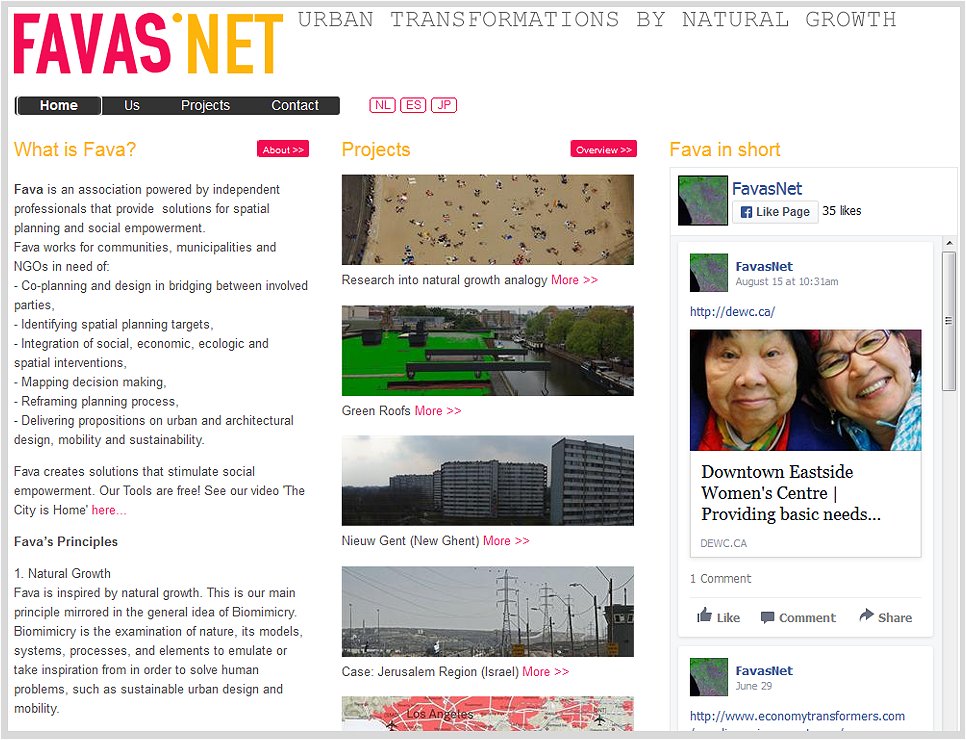Favas.net (in short: Fava) is a non-profit association of independent professionals committed to spatial solutions and social empowerment. The Fava-association is founded in 2009 and managed by Fava’s lead partner & editor RVDB Urban Planning (Dr. Rob van der Bijl MSc Architecture and Urban Planning). Our name is derived from the famous fava bean, on the human menu for thousands of years. In etymologic sense the name ‘fava’ is historically close to the name ‘Favela’. And sure, it has been no coincidence that the foundation of Favas.net was inspired by our experiences with the Favelas in Rio de Janeiro, Brazil, that are named by our bean. Favas.net uses biomimicry to mimic natural growth in urban planning.

Workshop at Manizales (Colombia)
Timeline
June 2025
Start of the multiple Scheveningen project (Netherlands)
January 2025
Cycling Community (& Fietscommunity Archive) incorporated in Favas.net
December 2024
Favas.net 15th anniversary in Antwerp (Belgium)
January 2021
RVDB Urban Planning becomes lead partner Favas.net
December 2019
Favas.net 10th anniversary celebration
June 2018
Launch of the new, improved and enlarged website

Website 2009-2018
July 2016
SAFE PLACES (Veiligwonen.nl) incorporated in Favas.net
April 2013
Start of the multiple Rotterdam project (Netherlands)

Rotterdam Zuid (Netherlands)
October 2010
‘The City is Home’ released by Favas.net
January 2010
Preparation of the first cases and projects
December 2009
Foundation of Favas.net by Pnina Avidar, Rob van der Bijl & Juliette van der Meijden

Helium stick game during a workshop
Contributions to Favas.net by
Pnina Avidar, Nida Batool Sheikh, Irène Bavencoff, Benikbram, Ymkje de Boer, Renée van der Bijl, Rob van der Bijl, Shelley Bontje, Wim Bot, Daan van der Burgh, Laurent Chambon, Tsaiher Cheng, Ntongwe Clovis Mbong, Emma Dijkstra, Danny Edwards, Jens Fiedler, Marek Jancovic, Martin Glastra van Loon, Co van Griensven, Mohamed Hassan, Eva Henckens, Ron van den Heuvel, Tobias Hooftman, Jos Huber, Oliwia Jackowska, Muhammad Wisal Khattak, Allard Kleinhuis, Geert Kloppenburg, Bart Koenen, Lex Koetzier, Raden Aliyya Putri Kusuma, Jaap Modder, Juliette van der Meijden, Robert Niessen, Laura Nino, Kazimierz (Kaz) Olszaniecki, Ben Pieron, Kees Pronk, Corentin Raimbaud, Onno Rieven, Roel Schoemaker, María Sempere Valdecantos, Raffaele (Lello) Sforza, Francis Sikkens, Liesbeth Sluiter, Martine Soffers, Bart van Spreeuwel, Hugo van der Steenhoven, Arjen van Susteren, Michael Tahmoressi, Jake Wiersma, Tobias Woldendorp and many others.
Our activities in particular countries made possible by Juliette van der Meijden (Brazil); Laura Mendoza, Njord Pattiasina, Camila Pinzon, Paul Ravenstijn, Nico Tillie, Philip Verma, Pepijn Verpalen (Colombia); Helge Bay (Denmark); Laurent Chambon, Geert Kloppenburg (France); Axel Kuehn (Germany), Raden Aliyya Putri Kusuma (Indonesia); Andrea Alessandri, Raffaele (Lello) Sforza (Italy), Koichiro Aitani, Dave van Eijnsbergen, Andrew David Fassam, Marc Glaudemans, Taichi Goto, Martin van der Linden, John Mader, Kei Minohara, Andy Pompilio, Emiko Szasz, Saline Verhoeven (Japan); Tom Potter (Norway); Bart Goldhoorn, Janine Hogendoorn, Johan Meijer, Anna Parkhomenko (Russia), Jaap Modder, Wendy Tan (Singapore), Andreas Berk (Switzerland), Jason Chang, Tsaiher Cheng, Ya-Wen Chen, Jody Chen, Casper Hsu, Charles Chin-rong Lin, Chou-Min Lin, Michel Sudarskis, (Taiwan), Thongchai Panswad (Thailand), Martin Glastra van Loon, Alan Moore (USA).

Workshop at Fukuoka (Japan)
CYCLING COMMUNITY project contributions by Andrea Alessandri, Francesco Baroncini, Renée van der Bijl, Rob van der Bijl, Shelley Bontje, Mirjam Borsboom, Marco te Brömmelstroet, Daan van der Burgh, Cosimo Chiffi, Henk-Jan Dekker, Bas Driessen, Clara Glachant, Janine Hogendoorn, Tobias Hooftman, Jos Huber, Allard Kleinhui, Kevin Krizek, Ruben Loendersloot, Maurits Lopes Cardozo, Davide Maggi, Samuel Nello-Deakin, José Oudijk, Féline De Pandelaere, Nico van Paridon, Paolo Pileri, Raffaele Sforza, Michael Tahmoressi, Jan Vlasblom, Hans van Vliet, Pieter van Wesemael, Muhammad Wisal Khattak, Francesca Zagarese and all contributors and founders mentioned at the former Fietscommunity (2013-2024).
SAFE PLACES / Veiligwonen.nl projects (1990-2016) were supported by Peter Bart, Betty van Bakel, Miranda Blomberg, Jelle de Boer, Rob Cornelissen, Sybille Denneman, Marc Dings, Jan van Dijk, Joop Doorman, Aart Eerland, Rieke Eerland, Waltraud Gerhardt, Arne Gielen, Paul Gruter, Nico Harkes, René Hesseling, Gertjan Hulster, Robbie Keus, Lex Koetzier, Harm-Jan Korthals Altes, Alexander Koutamanis, Tinus Kruger, Marc van Leusen, Susan Liebermann, Ita Luten, Fred Mutsaers, Hans Netten, Ralph Oei, Kazimierz (Kaz) Olszaniecki, Leen Prins, Kees Pronk, Petra Reijnhoudt, Jurgen Rosemann, René Scherpenisse, Paul van Soomeren, Liesbeth Sluiter, Egbert Stolk, Arjen van Susteren, Alexander Tzonis, Mieke van Veldhuizen, Peter Versteegh, Theo van der Voordt, Tobias Woldendorp, Chunlan Zhao, and Cora van Zwam.
The Dutch concept of ‘veilig wonen’ can literally be translated as ‘safe living’. Finally, ‘Safe Places’ was chosen as the English name. This translation is based on research by the Council for Scientific and Industrial Research (CSIR) in South Africa. In the late 90s, we worked together here with Susan Liebermann and Tinus Kruger on crime prevention. The concept ‘safe places’ is derived from their manual (with Karina Landman) ‘Designing Safer Places’ (CSIR, Pretoria, South Africa, 2001). Beware, the term ‘safe places’ should not be confused with the fashionable phenomenon of ‘safe spaces’ that is common in many of today’s American universities.

Favas.net supports Free Press Unlimited.

Favas.net is donor to the Wikimedia Foundation. We love being part of this important community. Like the other Wikipedians we share the feeling of belonging and appreciation, or rather, ‘WikiLove’.
